Cusco, Peru 作者: 来源: 发布时间:2021-03-23
1. Population and Areas
Cusco, often spelled Cuzco, is a city in southeastern Peru, on the eastern end of the Knot of Cuzco near the Urubamba Valley of the Andes mountain range. It is the capital of the Cusco Region and of the Cusco Province.
Population: 428,450 (2017 census)
Area: 385.1 km2(148.7 sq mi)
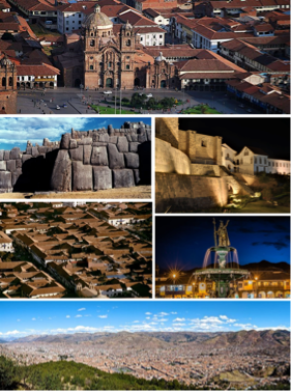
2.Geography
Cusco has a subtropical highland climate. It is generally dry and temperate, with two defined seasons. Winter occurs between April to September, with abundant sunshine and occasional nighttime freezes;Summer occurs between October and March, with warm temperatures and abundant rainfall.
Cusco was found in 2006 to be the spot on Earth with the highest average ultraviolet light level.

3. Economy
Tourism has been the backbone to the economy starting in the early 2000s, bringing in more than 1.2 million tourists per year.In 2002, the income Cusco received from tourism was US$837 million. In 2009, that number increased to US$2.47 billion
4. Industry
Backus and Johnston
It is the largest brewery in Peru, part of Bavaria Brewery,which itself is part of the international SABMiller group. Its main brewery is located in the Ate District of Lima. Backus, as owner of almost all brands of beer available in Peru, enjoys a de facto monopoly over Peruvian beer consumption, although recently many micro-breweries have arisen and Anheuser-Busch InBev from Brazil is trying to challenge the monopoly with their Brahma brand. Besides beer, Backus produces soft drinks and bottled water.
5.Main sights and Attractions

The indigenous Killke culture built the walled complex of Sacsayhuamán about 1100. The Killke built a major temple near Saksaywaman, as well as an aqueduct (Pukyus) and roadway connecting prehistoric structures. Saksaywaman was expanded by the Inca.
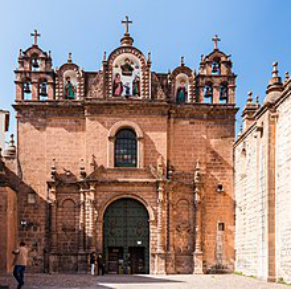
Templo de la Sagrada Familia
The Spanish explorer Pizarro sacked much of the Inca city in 1535. Remains of the palace of the Incas, Qurikancha (the Temple of the Sun) and the Temple of the Virgins of the Sun still stand. Inca buildings and foundations in some cases proved to be stronger than the foundations built in present-day Peru. Among the most noteworthy Spanish colonial buildings of the city is the Cathedral of Santo Domingo, Cusco.
The major nearby Inca sites are Pachacuti's presumed winter home, Machu Picchu, which can be reached on foot by the Inca Trail to Machu Picchu or by train; and the "fortress" at Ollantaytambo.
Barrio de San Blas
This neighborhood houses artisans, workshops and craft shops. It is one of the most picturesque sites in the city. Its streets are steep and narrow with old houses built by the Spanish over important Inca foundations. It has an attractive square and the oldest parish church in Cusco, built in 1563, which has a carved wooden pulpit considered the epitome of Colonial era woodwork in Cusco.
The Quechua name of this neighborhood is Tuq'ukachi, which means the opening of the salt.
Hatun Rumiyuq
This street is the most visited by tourists. On the street Hatun Rumiyoq ("the one with the big stone") was the palace of Inca Roca, which was converted to the Archbishop's residence.
Along this street that runs from the Plaza de Armas to the Barrio de San Blas, one can see the Stone of Twelve Angles, which is viewed as a marvel of ancient stonework and has become emblematic of the city's history.
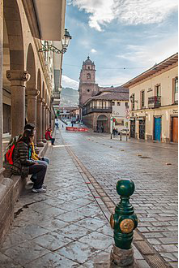
View of the bell tower of the Basilica of La Merced.
Basílica de la Merced
Its foundation dates from 1536. The first complex was destroyed by the earthquake of 1650. Its rebuilding was completed in 1675.
Its cloisters of Baroque Renaissance style, choir stalls, colonial paintings and wood carvings are highlights, now a popular museum.
Also on view is an elaborate monstrance made of gold and gemstones that weighs 22 kg (49 lb) and is 130 cm (51.18 in) in height.
Cathedral
The first cathedral built in Cusco is the Iglesia del Triunfo, built in 1539 on the foundations of the Palace of Viracocha Inca. Today, this church is an auxiliary chapel of the cathedral.
The main basilica cathedral of the city was built between 1560 and 1664. The main material used was stone, which was extracted from nearby quarries, although some blocks of red granite were taken from the fortress of Saksaywaman.
This great cathedral presents late-Gothic, Baroque and plateresque interiors and has one of the most outstanding examples of colonial goldwork. Its carved wooden altars are also important.
The city developed a distinctive style of painting known as the "Cuzco School" and the cathedral houses a major collection of local artists of the time. The cathedral is known for a Cusco School painting of the Last Supper depicting Jesus and the twelve apostles feasting on guinea pig, a traditional Andean delicacy.
The cathedral is the seat of the Archdiocese of Cuzco.
Plaza de Armas de Cusco
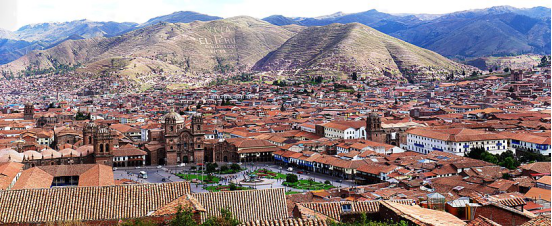
Known as the "Square of the warrior" in the Inca era, this plaza has been the scene of several important events, such as the proclamation by Francisco Pizarro in the conquest of Cuzco.
Iglesia de la Compañía de Jesús
Similarly, the Plaza de Armas was the scene of the death of Túpac Amaru II, considered the indigenous leader of the resistance.
The Spanish built stone arcades around the plaza which endure to this day. The main cathedral and the Church of La Compañía both open directly onto the plaza.
Iglesia de la Compañía de Jesús
This church (Church of the Society of Jesus), whose construction was initiated by the Jesuits in 1576 on the foundations of the Amarucancha or the palace of the Inca ruler Wayna Qhapaq, is considered one of the best examples of colonial baroque style in the Americas.
Its façade is carved in stone and its main altar is made of carved wood covered with gold leaf. It was built over an underground chapel and has a valuable collection of colonial paintings of the Cusco School.
Qurikancha and Convent of Santo Domingo
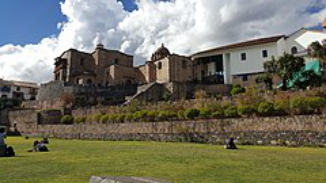
Qurikancha, Convento de Santo Domingo and Intipanpa
The Qurikancha ("golden place") was the most important sanctuary dedicated to the Sun God (Inti) at the time of the Inca Empire. According to ancient chronicles written by Garcilaso de la Vega (chronicler), Qurikancha was said to have featured a large solid golden disc that was studded with precious stones and represented the Inca Sun God – Inti. Spanish chroniclers describe the Sacred Garden in front of the temple as a garden of golden plants with leaves of beaten gold, stems of silver, solid gold corn-cobs and 20 life-size llamas and their herders all in solid gold.
The temple was destroyed by its Spanish invaders who, as they plundered, were determined to rid the city of its wealth, idolaters and shrines. Nowadays, only a curved outer wall and partial ruins of the inner temple remain at the site.
With this structure as a foundation, colonists built the Convent of Santo Domingo in the Renaissance style. The building, with one baroque tower, exceeds the height of many other buildings in this city.
Inside is a large collection of paintings from the Cuzco School.

Facade of the Museo de Arte Precolombino
Museums
Cusco has the following important museums:
Museo de Arte Precolombino
Casa Concha Museum (Machu Picchu Museum)
Museo Inka
Museo Histórico Regional de Cuzco
Centro de Textiles Tradicionales del Cuzco or Center of the Traditional Textiles of Cusco in English
Museum of Sacred, Magical and Medicinal Plants (Museo de plantas sagradas, mágicas y medicinales)
ChocoMuseo (The Cacao and Chocolate Museum)
6.History
The city was the historic capital of the Inca Empirefrom the 13th century until the 16th-century Spanish conquest.
Inca history
Cusco was long an important center of indigenous people. It was the capital of the Inca Empire (13th century – 1532). Many believe that the city was planned as an effigy in the shape of a puma, a sacred animal. How Cusco was specifically built, or how its large stones were quarried and transported to the site remain undetermined. Under the Inca, the city had two sectors: the urin and hanan. Each was divided to encompass two of the four provinces, Chinchasuyu (NW), Antisuyu (NE), Kuntisuyu (SW) and Qullasuyu (SE). A road led from each quarter to the corresponding quarter of the empire.
Each local leader was required to build a house in the city and live part of the year in Cusco, restricted to the quarter that corresponded to the quarter in which he held territory. After the rule of Pachacuti, when an Inca died, his title went to one son and his property was given to a corporation controlled by his other relatives (split inheritance). Each title holder had to build a new house and add new lands to the empire, in order to own land for his family to keep after his death.
According to Inca legend, the city was rebuilt by Sapa Inca Pachacuti, the man who transformed the Kingdom of Cuzco from a sleepy city-state into the vast empire of Tawantinsuyu.66–69Archaeological evidence, however, points to a slower, more organic growth of the city beginning before Pachacuti. The city was constructed according to a definite plan in which two rivers were channeled around the city. Archaeologists have suggested that this city plan was replicated at other sites.
The city fell to the sphere of Huáscar during the Inca Civil War after the death of Huayna Capac in 1528. It was captured by the generals of Atahualpa in April 1532 in the Battle of Quipaipan. Nineteen months later, Spanish explorers invaded the city after kidnapping and murdering Atahualpa (see Battle of Cuzco), and gained control because of their arms and horses, employing superior military technology.
7.Other information
In 1933, the Congress of Americanists met in La Plata, Argentina, and declared the city as the Archeological Capital of the Americas.
In 1978, the 7th Convention of Mayors of Great World Cities met in Milan, Italy, and declared Cusco a Cultural Heritage of the World.
In 1983, UNESCO, in Paris, France, declared the city a World Heritage Site. The Peruvian government declared it the Tourism Capital of Peru and Cultural Heritage of the Nation.
In 2007, the New7Wonders Foundation designated Machu Picchu one of the New Seven Wonders of the World, following a worldwide poll.
8. Contact Information
Address of the municipal government: Plaza Regocijos S/N, Cusco, Peru
Tel:51(84)240006
Fax:226701
email: webmaster@municusco.gob.pe
municipalidad@municusco.gob.pe
Facebook: Municipalidad del Cusco
Website: http://www.municusco.gob.pe
Mayor: Víctor G. Boluarte Medina
